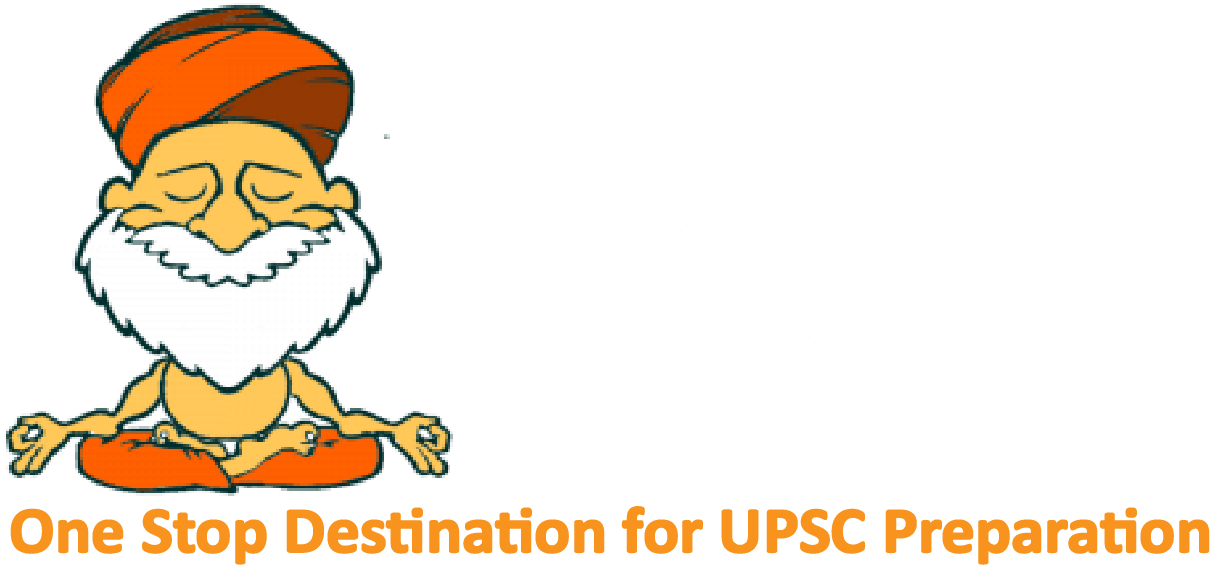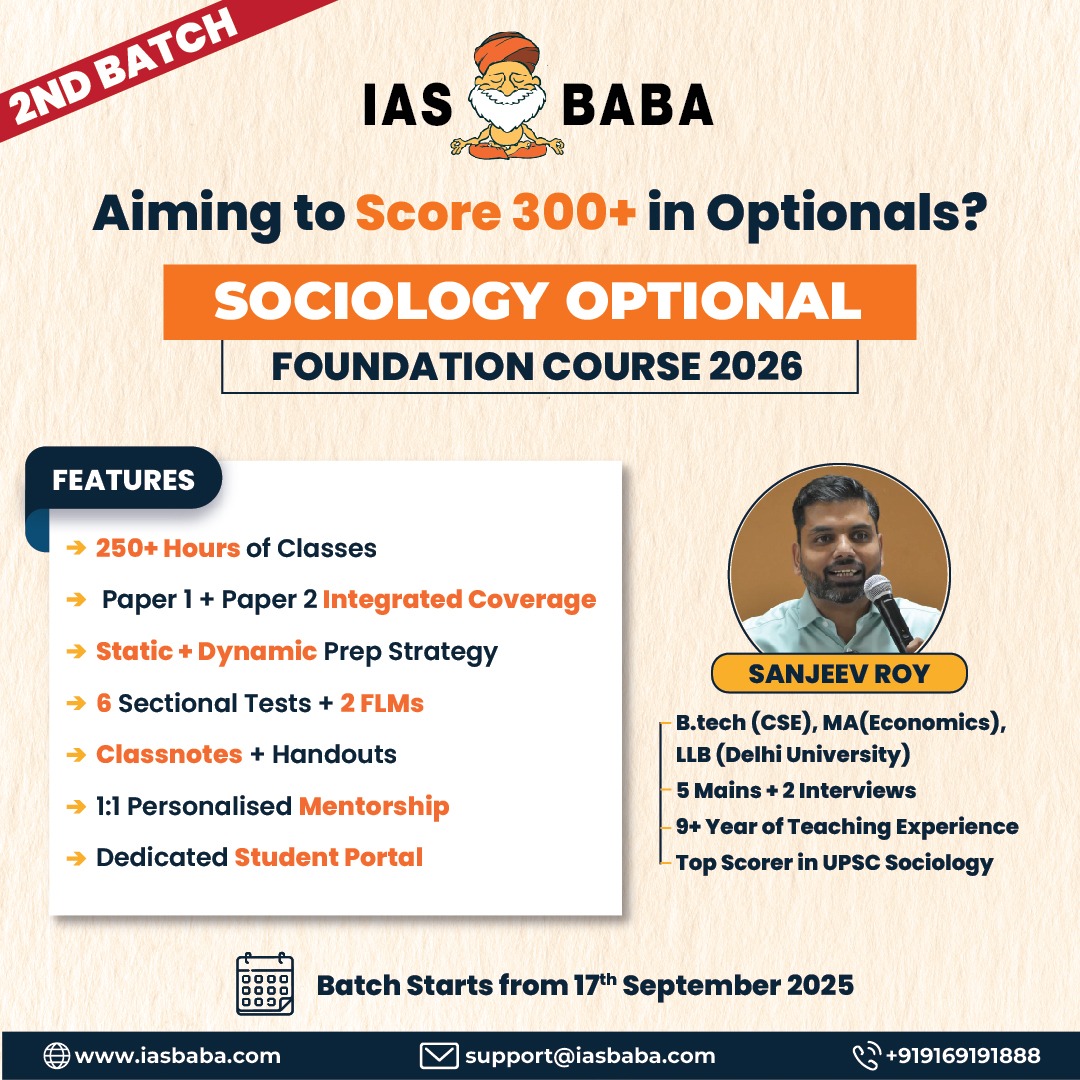IASbaba Prelims 60 Days Plan, Rapid Revision Series (RaRe)
Archives
Hello Friends
The 60 Days Rapid Revision (RaRe) Series is IASbaba’s Flagship Initiative recommended by Toppers and loved by the aspirants’ community every year.
It is the most comprehensive program which will help you complete the syllabus, revise and practice tests on a daily basis. The Programme on a daily basis includes
Daily Prelims MCQs from Static (Monday – Saturday)
- Daily Static Quiz will cover all the topics of static subjects – Polity, History, Geography, Economics, Environment and Science and technology.
- 20 questions will be posted daily and these questions are framed from the topics mentioned in the schedule.
- It will ensure timely and streamlined revision of your static subjects.
Daily Current Affairs MCQs (Monday – Saturday)
- Daily 5 Current Affairs questions, based on sources like ‘The Hindu’, ‘Indian Express’ and ‘PIB’, would be published from Monday to Saturday according to the schedule.
Daily CSAT Quiz (Monday – Friday)
- CSAT has been an Achilles heel for many aspirants.
- Daily 5 CSAT Questions will be published.
Note – Daily Test of 20 static questions, 10 current affairs, and 5 CSAT questions. (35 Prelims Questions) in QUIZ FORMAT will be updated on a daily basis.
To Know More about 60 Days Rapid Revision (RaRe) Series – CLICK HERE
60 Day Rapid Revision (RaRe) Series Schedule – CLICK HERE
Important Note
- Comment your Scores in the Comment Section. This will keep you accountable, responsible and sincere in days to come.
- It will help us come out with the Cut-Off on a Daily Basis.
- Let us know if you enjoyed today’s test 🙂
- You can post your comments in the given format
- (1) Your Score
- (2) Matrix Meter
- (3) New Learning from the Test
Test-summary
0 of 35 questions completed
Questions:
- 1
- 2
- 3
- 4
- 5
- 6
- 7
- 8
- 9
- 10
- 11
- 12
- 13
- 14
- 15
- 16
- 17
- 18
- 19
- 20
- 21
- 22
- 23
- 24
- 25
- 26
- 27
- 28
- 29
- 30
- 31
- 32
- 33
- 34
- 35
Information
The following Test is based on the syllabus of 60 Days Plan-2025 for UPSC IAS Prelims 2025.
To view Solutions, follow these instructions:
- Click on – ‘Start Test’ button
- Solve Questions
- Click on ‘Test Summary’ button
- Click on ‘Finish Test’ button
- Now click on ‘View Questions’ button – here you will see solutions and links.
You have already completed the test before. Hence you can not start it again.
Test is loading...
You must sign in or sign up to start the test.
You have to finish following test, to start this test:
Results
0 of 35 questions answered correctly
Your time:
Time has elapsed
You have scored 0 points out of 0 points, (0)
| Average score |
|
| Your score |
|
Categories
- Not categorized 0%
| Pos. | Name | Entered on | Points | Result |
|---|---|---|---|---|
| Table is loading | ||||
| No data available | ||||
- 1
- 2
- 3
- 4
- 5
- 6
- 7
- 8
- 9
- 10
- 11
- 12
- 13
- 14
- 15
- 16
- 17
- 18
- 19
- 20
- 21
- 22
- 23
- 24
- 25
- 26
- 27
- 28
- 29
- 30
- 31
- 32
- 33
- 34
- 35
- Answered
- Review
-
Question 1 of 35
1. Question
With reference to the ‘National Gene Bank of India’, which of the following statements is/are correct?
- It is mainly concerned with in situ conservation in a seed gene bank.
- It is primarily responsible for conservation of unique accessions on long-term basis.
Select the answer using the code given below:
Correct
Solution (b)
Explanation:
- The National Gene Bank of India is primarily concerned with ex situ conservation, not in situ conservation. In ex situ conservation, genetic material is conserved outside its natural habitat, typically in seed banks, gene banks, or tissue culture labs. In situ conservation, on the other hand, refers to the conservation of species in their natural habitats. The National Gene Bank stores seeds, DNA, and other genetic material in controlled conditions to ensure the preservation of biodiversity. (Statements 1 is incorrect)
- The National Gene Bank is responsible for the long-term conservation of unique accessions of plant genetic resources. It preserves seeds and other genetic material for long-term storage, ensuring the availability of these resources for future generations. The gene bank helps safeguard biodiversity and supports agricultural research, breeding programs, and conservation efforts. (Statement 2 is correct)
- The National Gene Bank (NGB) in India is a facility at the National Bureau of Plant Genetic Resources (NBPGR) in New Delhi that works to preserve plant genetic resources (PGR) for future generations.
Incorrect
Solution (b)
Explanation:
- The National Gene Bank of India is primarily concerned with ex situ conservation, not in situ conservation. In ex situ conservation, genetic material is conserved outside its natural habitat, typically in seed banks, gene banks, or tissue culture labs. In situ conservation, on the other hand, refers to the conservation of species in their natural habitats. The National Gene Bank stores seeds, DNA, and other genetic material in controlled conditions to ensure the preservation of biodiversity. (Statements 1 is incorrect)
- The National Gene Bank is responsible for the long-term conservation of unique accessions of plant genetic resources. It preserves seeds and other genetic material for long-term storage, ensuring the availability of these resources for future generations. The gene bank helps safeguard biodiversity and supports agricultural research, breeding programs, and conservation efforts. (Statement 2 is correct)
- The National Gene Bank (NGB) in India is a facility at the National Bureau of Plant Genetic Resources (NBPGR) in New Delhi that works to preserve plant genetic resources (PGR) for future generations.
-
Question 2 of 35
2. Question
Consider the following statements:
- GRIHA is a rating tool that evaluates the environmental performance of a building holistically over its entire life cycle.
- The GRIHA rating system is developed by NITI Aayog.
Which of the above statements is/are correct?
Correct
Solution (a)
Explanation:
- GRIHA is an acronym for Green Rating for Integrated Habitat Assessment. GRIHA is a Sanskrit word meaning ‘Abode.’ It is a rating tool that helps people assesses the performance of their building against certain nationally acceptable benchmarks. It evaluates the environmental performance of a building holistically over its entire life cycle, thereby providing a definitive standard for what constitutes a ‘green building.’ Hence, statement 1 is correct.
- The GRIHA rating system, based on accepted energy and environmental principles is developed by TERI (The Energy and Resources Institute) and it has been adopted by the Ministry of New and Renewable Energy. It assesses a building out of 34 criteria and awards points on a scale of 100. In order to qualify for GRIHA certification, a project must achieve at least 50 points. Hence, statement 2 is not correct.
Incorrect
Solution (a)
Explanation:
- GRIHA is an acronym for Green Rating for Integrated Habitat Assessment. GRIHA is a Sanskrit word meaning ‘Abode.’ It is a rating tool that helps people assesses the performance of their building against certain nationally acceptable benchmarks. It evaluates the environmental performance of a building holistically over its entire life cycle, thereby providing a definitive standard for what constitutes a ‘green building.’ Hence, statement 1 is correct.
- The GRIHA rating system, based on accepted energy and environmental principles is developed by TERI (The Energy and Resources Institute) and it has been adopted by the Ministry of New and Renewable Energy. It assesses a building out of 34 criteria and awards points on a scale of 100. In order to qualify for GRIHA certification, a project must achieve at least 50 points. Hence, statement 2 is not correct.
-
Question 3 of 35
3. Question
Consider the following statements:
Statement-I: World Wetlands Day is celebrated on 2nd February every year.
Statement-II: The Ramsar Convention on wetlands was adopted on 2nd February, 1971.
Which one of the following is correct in respect of the above statements?
Correct
Solution (a)
Explanation:
- The Ramsar Convention is an intergovernmental treaty, adopted on 2nd February 1971, in the Iranian city of Ramsar, on the southern shore of the Caspian Sea. To commemorate the adoption of this international agreement on wetlands, World Wetlands Day is celebrated on 2nd February every year. The theme of World Wetland Day, 2024 is ‘Wetlands and Human Wellbeing’ which underscores the critical role wetlands play in enhancing our lives. Hence, option a is the correct answer.
Incorrect
Solution (a)
Explanation:
- The Ramsar Convention is an intergovernmental treaty, adopted on 2nd February 1971, in the Iranian city of Ramsar, on the southern shore of the Caspian Sea. To commemorate the adoption of this international agreement on wetlands, World Wetlands Day is celebrated on 2nd February every year. The theme of World Wetland Day, 2024 is ‘Wetlands and Human Wellbeing’ which underscores the critical role wetlands play in enhancing our lives. Hence, option a is the correct answer.
-
Question 4 of 35
4. Question
With reference to Intergovernmental Panel on Climate Change (IPCC), consider the
following statements:
- The Intergovernmental Panel on Climate Change (IPCC) is the United Nations body for assessing the science related to climate change.
- Till now, IPCC has produced 16 assessment reports that provide guidelines for estimating greenhouse gas emissions and removal.
- IPCC undertakes extensive scientific researches to produce these assessment reports.
Which of the above statements are INCORRECT?
Correct
Solution (c)
Explanation:
- The Intergovernmental Panel on Climate Change (IPCC) is the United Nations body for assessing the science related to climate change. It is an intergovernmental body of the UN constituted to advance scientific knowledge about climate change caused by human activities. Hence, statement 1 is correct.
- The IPCC prepares comprehensive Assessment Reports about the state of scientific, technical and socio-economic knowledge on climate change, its impacts and future risks, and options for reducing the rate at which climate change is taking place. The latest report is the Sixth (not sixteenth) Assessment Report which consists of three Working Group contributions and a Synthesis Report. Hence, statement 2 is INCORRECT.
- The IPCC does not itself undertake scientific assessments but only evaluates the state of scientific evidence on various aspects of climate change. It has 195 member states who elect a bureau of scientists to serve through an assessment cycle and the bureau selects experts to prepare IPCC reports. Hence, statement 3 is INCORRECT.
Incorrect
Solution (c)
Explanation:
- The Intergovernmental Panel on Climate Change (IPCC) is the United Nations body for assessing the science related to climate change. It is an intergovernmental body of the UN constituted to advance scientific knowledge about climate change caused by human activities. Hence, statement 1 is correct.
- The IPCC prepares comprehensive Assessment Reports about the state of scientific, technical and socio-economic knowledge on climate change, its impacts and future risks, and options for reducing the rate at which climate change is taking place. The latest report is the Sixth (not sixteenth) Assessment Report which consists of three Working Group contributions and a Synthesis Report. Hence, statement 2 is INCORRECT.
- The IPCC does not itself undertake scientific assessments but only evaluates the state of scientific evidence on various aspects of climate change. It has 195 member states who elect a bureau of scientists to serve through an assessment cycle and the bureau selects experts to prepare IPCC reports. Hence, statement 3 is INCORRECT.
-
Question 5 of 35
5. Question
With reference to United Nations Conference on the Human Environment, 1972 consider the following statements:
- It was held in Stockholm, Sweden.
- It is famously known as ‘Earth Summit.’
- It marked the emergence of international environmental law.
Which of the above statements are correct?
Correct
Solution (b)
Explanation:
- The 1972 United Nations Conference on the Human Environment, also known as the Stockholm Declaration, contained 26 principles, and placed environmental issues at the forefront of international concerns and marked the start of a dialogue between industrialized and developing countries on the link between economic growth, the pollution of the air, water, and oceans and the well-being of people around the world. Hence, statement 1 is correct.
- The United Nations Conference on Environment and Development (UNCED), which was held in Rio de Janeiro, Brazil, in 1992 was also known as the ‘Earth Summit.’ It concluded that the concept of sustainable development was an attainable goal for all the people of the world, regardless of whether they were at the local, national, regional or international level. Hence, statement 2 is not correct.
The 1972 United Nations Conference on the Human Environment in Stockholm was the first world conference to make the environment a major issue. The participants adopted a series of principles for sound management of the environment including the Stockholm Declaration and Action Plan for the Human Environment and several resolutions. Hence, statement 3 is correct.
Incorrect
Solution (b)
Explanation:
- The 1972 United Nations Conference on the Human Environment, also known as the Stockholm Declaration, contained 26 principles, and placed environmental issues at the forefront of international concerns and marked the start of a dialogue between industrialized and developing countries on the link between economic growth, the pollution of the air, water, and oceans and the well-being of people around the world. Hence, statement 1 is correct.
- The United Nations Conference on Environment and Development (UNCED), which was held in Rio de Janeiro, Brazil, in 1992 was also known as the ‘Earth Summit.’ It concluded that the concept of sustainable development was an attainable goal for all the people of the world, regardless of whether they were at the local, national, regional or international level. Hence, statement 2 is not correct.
The 1972 United Nations Conference on the Human Environment in Stockholm was the first world conference to make the environment a major issue. The participants adopted a series of principles for sound management of the environment including the Stockholm Declaration and Action Plan for the Human Environment and several resolutions. Hence, statement 3 is correct.
-
Question 6 of 35
6. Question
Which of the following statements is/are correct about UN Convention to Combat Desertification (UNCCD)?
- It aims to protect and restore land, and combat desertification and drought.
- It is a legally binding agreement.
- Its permanent Secretariat is located in Bonn, Germany.
Select the answer using given code:
Correct
Solution (d)
Explanation:
- The UN Convention to Combat Desertification (UNCCD) aims to protect and restore land, and combat desertification and drought. It is the only convention stemming from a direct recommendation of the Rio Conference’s Agenda 21. It was adopted in Paris, France, in June 1994 and entered into force in December 1996. Hence, statement 1 is correct.
- It is the only internationally legally binding framework set up to address the problem of desertification. The Convention is based on the principles of participation, partnership and decentralization- the backbone of good governance and sustainable development. It has 197 parties, making it near universal in reach. Hence, statement 2 is correct.
Its permanent Secretariat is located in Bonn, Germany. The functions of the secretariat are to make arrangements for sessions of the Conference of the Parties (COP) and its subsidiary bodies established under the Convention, and to provide them with services as required. Hence, statement 3 is correct.
Incorrect
Solution (d)
Explanation:
- The UN Convention to Combat Desertification (UNCCD) aims to protect and restore land, and combat desertification and drought. It is the only convention stemming from a direct recommendation of the Rio Conference’s Agenda 21. It was adopted in Paris, France, in June 1994 and entered into force in December 1996. Hence, statement 1 is correct.
- It is the only internationally legally binding framework set up to address the problem of desertification. The Convention is based on the principles of participation, partnership and decentralization- the backbone of good governance and sustainable development. It has 197 parties, making it near universal in reach. Hence, statement 2 is correct.
Its permanent Secretariat is located in Bonn, Germany. The functions of the secretariat are to make arrangements for sessions of the Conference of the Parties (COP) and its subsidiary bodies established under the Convention, and to provide them with services as required. Hence, statement 3 is correct.
-
Question 7 of 35
7. Question
With reference to United Nations Environment Programme (UNEP), consider the following statements:
- The United Nations Environment Programme (UNEP) is the leading global authority on the environment.
- The UNEP is headquartered in Nairobi, Kenya, making it the first UN headquarters in the Global South.
- The Emission Gap Report is released annually by UNEP.
How many of the statements given above is/are correct?
Correct
Solution (c)
Explanation:
- The United Nations Environment Programme (UNEP) is the leading global authority on the environment. Through scientific studies, policy support, intergovernmental coordination and public advocacy, UNEP helps humanity to foster climate stability, live in harmony with nature and forge a pollution-free future, in line with the 2030 Agenda for Sustainable Development. Hence, statement 1 is correct.
- On 15 December, 1972, the 27th session of the UN General Assembly officially adopted Nairobi as UNEP’s home base, making it the first UN headquarters in the Global South. This decision responded to a strong call from countries in the Global South to locate the fledgling agency in the developing world, which would have a crucial role to play in the environmental movement to follow. Hence, statement 2 is correct.
- Emission Gap Report, Adaptation Gap Report, Global Environment Outlook are the major reports released by United Nations Environment Programme (UNEP). Some of the major campaigns launched by UNEP include Beat Pollution, UN75, World Environment Day, Wild for Life. Hence, statement 3 is correct.
Incorrect
Solution (c)
Explanation:
- The United Nations Environment Programme (UNEP) is the leading global authority on the environment. Through scientific studies, policy support, intergovernmental coordination and public advocacy, UNEP helps humanity to foster climate stability, live in harmony with nature and forge a pollution-free future, in line with the 2030 Agenda for Sustainable Development. Hence, statement 1 is correct.
- On 15 December, 1972, the 27th session of the UN General Assembly officially adopted Nairobi as UNEP’s home base, making it the first UN headquarters in the Global South. This decision responded to a strong call from countries in the Global South to locate the fledgling agency in the developing world, which would have a crucial role to play in the environmental movement to follow. Hence, statement 2 is correct.
- Emission Gap Report, Adaptation Gap Report, Global Environment Outlook are the major reports released by United Nations Environment Programme (UNEP). Some of the major campaigns launched by UNEP include Beat Pollution, UN75, World Environment Day, Wild for Life. Hence, statement 3 is correct.
-
Question 8 of 35
8. Question
Consider the following statements:
- National Forest Policy of India, 1988 envisages a goal of achieving 25% of the geographical area of the country under forest and tree cover.
- Forest cover includes all lands having trees of more than one hectare in an area with a tree canopy density of more than 33%, irrespective of ownership and species composition of trees.
- India State of Forest Report (ISFR) is an annual publication of Forest Survey of India.
How many of the above statements is/are correct?
Correct
Solution (d)
Explanation:
- National Forest Policy of India, 1988 envisages a goal of achieving 33% of the geographical area of the country under forest and tree cover. The National Forest Policy, 1988 was brought as an Act of the Parliament of India to revise the previously enacted National Forest Policy of 1952. It strongly suggested the idea of empowering and involving local communities in the protection and development of forests. Hence, statement 1 is not correct.
- India State of Forest Report (ISFR) is a biennial publication of Forest Survey of India (FSI), an organization under the Ministry of Environment Forest & Climate Change. Hence, statement 2 is not correct.
- Forest cover includes all lands having trees of more than one hectare in an area with a tree canopy density of more than 10%, irrespective of ownership, the legal status of the land, and species composition of trees. Hence, statement 3 is not correct.
Incorrect
Solution (d)
Explanation:
- National Forest Policy of India, 1988 envisages a goal of achieving 33% of the geographical area of the country under forest and tree cover. The National Forest Policy, 1988 was brought as an Act of the Parliament of India to revise the previously enacted National Forest Policy of 1952. It strongly suggested the idea of empowering and involving local communities in the protection and development of forests. Hence, statement 1 is not correct.
- India State of Forest Report (ISFR) is a biennial publication of Forest Survey of India (FSI), an organization under the Ministry of Environment Forest & Climate Change. Hence, statement 2 is not correct.
- Forest cover includes all lands having trees of more than one hectare in an area with a tree canopy density of more than 10%, irrespective of ownership, the legal status of the land, and species composition of trees. Hence, statement 3 is not correct.
-
Question 9 of 35
9. Question
Which of the following protocol/convention regulates the transboundary movement of living modified organisms (LMOs)?
Correct
Solution (b)
Explanation:
The Cartagena Protocol on Biosafety to the Convention on Biological Diversity is an international agreement which aims to ensure the safe handling, transport and use of living modified organisms (LMOs) resulting from modern biotechnology that may have adverse effects on biological diversity, taking also into account risks to human health. It was adopted on 29 January 2000 and entered into force on 11 September 2003. Hence, option b is the correct option.
Incorrect
Solution (b)
Explanation:
The Cartagena Protocol on Biosafety to the Convention on Biological Diversity is an international agreement which aims to ensure the safe handling, transport and use of living modified organisms (LMOs) resulting from modern biotechnology that may have adverse effects on biological diversity, taking also into account risks to human health. It was adopted on 29 January 2000 and entered into force on 11 September 2003. Hence, option b is the correct option.
-
Question 10 of 35
10. Question
Consider the following statements about Kigali Amendment:
- The Kigali Amendment to the Montreal Protocol aims to phase out the use of potent greenhouse gases called hydrofluorocarbons (HFCs).
- The Kigali Amendment to the Montreal Protocol is legally binding treaty with mandatory targets for countries.
Which of the above statements is/are correct?
Correct
Solution (c)
Explanation:
- The Montreal Protocol on Substances that Deplete the Ozone Layer is the landmark multilateral environmental agreement that regulates the production and consumption of nearly 100 man-made chemicals referred to as ozone depleting substances (ODS). Under the Kigali Amendment; Parties to the Montreal Protocol will phase down production and consumption of Hydrofluorocarbons, commonly known as HFCs. Hence, statement 1 is correct.
At the Kigali meeting, the world agreed to reduce the use of HFCs and move to refrigerants that neither cause global warming nor create an ozone hole. Notably, unlike Paris Agreement (where there are no repercussions for non-compliance), the Kigali Amendment to the Montreal Protocol is legally binding with mandatory targets for countries. Hence, statement 2 is correct.
Incorrect
Solution (c)
Explanation:
- The Montreal Protocol on Substances that Deplete the Ozone Layer is the landmark multilateral environmental agreement that regulates the production and consumption of nearly 100 man-made chemicals referred to as ozone depleting substances (ODS). Under the Kigali Amendment; Parties to the Montreal Protocol will phase down production and consumption of Hydrofluorocarbons, commonly known as HFCs. Hence, statement 1 is correct.
At the Kigali meeting, the world agreed to reduce the use of HFCs and move to refrigerants that neither cause global warming nor create an ozone hole. Notably, unlike Paris Agreement (where there are no repercussions for non-compliance), the Kigali Amendment to the Montreal Protocol is legally binding with mandatory targets for countries. Hence, statement 2 is correct.
-
Question 11 of 35
11. Question
The 30 by 30 (30X30) target, which aims to designate 30% of Earth’s land and ocean area as protected areas by 2030 is launched by?
Correct
Solution (c)
Explanation:
30 by 30 (or 30×30) is a worldwide initiative was launched by the High Ambition Coalition for Nature and People (HAC) in 2020 for governments to designate 30% of Earth’s land and ocean area as protected areas by 2030. The High Ambition Coalition (HAC) for Nature and People was launched in 2019 by Costa Rica, France and Britain as an intergovernmental group to champion a global deal for nature and people that can halt the accelerating loss of species, and protect vital ecosystems. Hence, option c is the correct answer.
Incorrect
Solution (c)
Explanation:
30 by 30 (or 30×30) is a worldwide initiative was launched by the High Ambition Coalition for Nature and People (HAC) in 2020 for governments to designate 30% of Earth’s land and ocean area as protected areas by 2030. The High Ambition Coalition (HAC) for Nature and People was launched in 2019 by Costa Rica, France and Britain as an intergovernmental group to champion a global deal for nature and people that can halt the accelerating loss of species, and protect vital ecosystems. Hence, option c is the correct answer.
-
Question 12 of 35
12. Question
With reference to Paris Agreement, consider the following statements:
- The Paris Agreement is a legally binding international treaty on climate change.
- It was adopted by 196 Parties at the UN Climate Change Conference (COP21) in December 2015.
- Its overarching goal is to hold the increase in the global average temperature to well below 2°C above pre-industrial levels.
Which of the above statements is/are correct?
Correct
Solution (d)
Explanation:
- The Paris Agreement is a legally binding international treaty on climate change. It provides a durable framework guiding the global effort for decades to come. It marks the beginning of a shift towards a net-zero emissions world. Implementation of the Agreement is also essential for the achievement of the Sustainable Development Goals. Hence, statement 1 is correct.
- The Paris Agreement was adopted by 196 Parties at the UN Climate Change Conference (COP21) in Paris, France, on 12 December 2015. It entered into force on 4 November 2016. Today, 195 Parties (194 States plus the European Union) have joined the Paris Agreement. Hence, statement 2 is correct.
- The Paris Agreement sets long-term goals to guide all nations to substantially reduce global greenhouse gas emissions to hold global temperature increase to well below 2°C above pre-industrial levels and pursue efforts to limit it to 1.5°C above pre-industrial levels, recognizing that this would significantly reduce the risks and impacts of climate change. Hence, statement 3 is correct.
Incorrect
Solution (d)
Explanation:
- The Paris Agreement is a legally binding international treaty on climate change. It provides a durable framework guiding the global effort for decades to come. It marks the beginning of a shift towards a net-zero emissions world. Implementation of the Agreement is also essential for the achievement of the Sustainable Development Goals. Hence, statement 1 is correct.
- The Paris Agreement was adopted by 196 Parties at the UN Climate Change Conference (COP21) in Paris, France, on 12 December 2015. It entered into force on 4 November 2016. Today, 195 Parties (194 States plus the European Union) have joined the Paris Agreement. Hence, statement 2 is correct.
- The Paris Agreement sets long-term goals to guide all nations to substantially reduce global greenhouse gas emissions to hold global temperature increase to well below 2°C above pre-industrial levels and pursue efforts to limit it to 1.5°C above pre-industrial levels, recognizing that this would significantly reduce the risks and impacts of climate change. Hence, statement 3 is correct.
-
Question 13 of 35
13. Question
With respect to Mission LiFE, consider the following statements:
- Mission LiFE (Lifestyle for Environment) was launched by Prime Minister Narendra Modi at COP27 in Sharm El-Sheikh, Egypt.
- The Mission LiFE emboldens the spirit of the P3 model, i.e., Pro Planet People.
Which of the above statements is/are correct?
Correct
Solution (b)
Explanation:
- Mission LiFE was introduced by Prime Minister Narendra Modi—at COP26 in Glasgow on 1 November 2021—as a mass movement for “mindful and deliberate utilization, instead of mindless and destructive consumption” to protect and preserve the environment. According to the United Nations Environment Programme (UNEP), if 1 out of 8 billion people worldwide adopt environment-friendly behaviours in their daily lives, global carbon emissions could drop up to 20%. Hence, statement 1 is not correct.
Mission LiFE aims to nudge individuals and communities to practice a lifestyle that is synchronous with nature and does not harm it. Those who practice such a lifestyle are recognised as Pro Planet People. India is the first country to include LiFE in its Nationally Determined Contributions (NDCs). Hence, statement 2 is correct.
Incorrect
Solution (b)
Explanation:
- Mission LiFE was introduced by Prime Minister Narendra Modi—at COP26 in Glasgow on 1 November 2021—as a mass movement for “mindful and deliberate utilization, instead of mindless and destructive consumption” to protect and preserve the environment. According to the United Nations Environment Programme (UNEP), if 1 out of 8 billion people worldwide adopt environment-friendly behaviours in their daily lives, global carbon emissions could drop up to 20%. Hence, statement 1 is not correct.
Mission LiFE aims to nudge individuals and communities to practice a lifestyle that is synchronous with nature and does not harm it. Those who practice such a lifestyle are recognised as Pro Planet People. India is the first country to include LiFE in its Nationally Determined Contributions (NDCs). Hence, statement 2 is correct.
-
Question 14 of 35
14. Question
With reference to Central Pollution Control Board (CPCB), consider the following
statements:
- CPCB is a statutory organisation constituted under the Water (Prevention and Control of Pollution) Act, 1974.
- It comes under Ministry of Science and Technology.
- The headquarter of CBCB is located in Bengaluru.
Which of the above statements is/are correct?
Correct
Solution (a)
Explanation:
- The Central Pollution Control Board (CPCB) is a statutory organisation constituted in September 1974 under the Water (Prevention and Control of Pollution) Act, 1974. Further, CPCB was entrusted with the powers and functions under the Air (Prevention and Control of Pollution) Act, 1981. It also provides technical services to the Ministry of Environment, Forests, and Climate Change (MOEFCC) under the provisions of the Environment (Protection) Act, 1986. Hence, statement 1 is correct.
- The Central Pollution Control Board (CPCB) of India comes under the Ministry of Environment, Forest and Climate Change (MoEFCC). It is the apex organization in country in the field of pollution control, as a technical wing of MoEFCC. The board is led by its chairperson appointed by the Appointments Committee of the Cabinet of the Government of India. Hence, statement 2 is not correct.
- The headquarter of Central Pollution Control Board (CPCB) is located in New Delhi, with seven zonal offices and 5 laboratories. The board conducts environmental assessments and research. It is responsible for maintaining national standards under a variety of environmental laws, in consultation with zonal offices, tribal, and local governments. Hence, statement 3 is not correct.
Incorrect
Solution (a)
Explanation:
- The Central Pollution Control Board (CPCB) is a statutory organisation constituted in September 1974 under the Water (Prevention and Control of Pollution) Act, 1974. Further, CPCB was entrusted with the powers and functions under the Air (Prevention and Control of Pollution) Act, 1981. It also provides technical services to the Ministry of Environment, Forests, and Climate Change (MOEFCC) under the provisions of the Environment (Protection) Act, 1986. Hence, statement 1 is correct.
- The Central Pollution Control Board (CPCB) of India comes under the Ministry of Environment, Forest and Climate Change (MoEFCC). It is the apex organization in country in the field of pollution control, as a technical wing of MoEFCC. The board is led by its chairperson appointed by the Appointments Committee of the Cabinet of the Government of India. Hence, statement 2 is not correct.
- The headquarter of Central Pollution Control Board (CPCB) is located in New Delhi, with seven zonal offices and 5 laboratories. The board conducts environmental assessments and research. It is responsible for maintaining national standards under a variety of environmental laws, in consultation with zonal offices, tribal, and local governments. Hence, statement 3 is not correct.
-
Question 15 of 35
15. Question
With respect to National Action Plan for Climate Change (NAPCC), consider the following statements:
- The National Action Plan on Climate Change (NAPCC) was released by Prime Minister’s Council on Climate Change (PMCCC) in 2014.
- It outlines a national strategy that aims to enable the country to adapt to climate change and enhance the ecological sustainability of India’s development path.
- National Solar Mission is a part of the National Action Plan on Climate Change (NAPCC).
Which of the above statements is/are correct?
Correct
Solution (c)
Explanation:
- The National Action Plan on Climate Change (NAPCC) was designed and published under the guidance of Prime Minister’s Council on Climate Change (PMCCC) in 2008 to mitigate and adapt to the adverse impact of climate change. Hence, statement 1 is not correct.
- NAPCC outlines a national strategy that aims to enable the country to adapt to climate change and enhance the ecological sustainability of India’s development path. It stresses that maintaining a high growth rate is essential for increasing living standards of the vast majority of people of India and reducing their vulnerability to the impacts of climate change. It also co-ordinates the activities of the State Board and resolve disputes among them. Hence, statement 2 is correct.
-
- There are eight National Missions which form the core of the National Action Plan. They focus on promoting understanding of climate change, adaptation and mitigation, energy efficiency and natural resource conservation. These are:
- National Solar Mission.
- National Mission for Enhanced Energy Efficiency.
- National Mission on Sustainable Habitat.
- National Water Mission.
- National Mission for Sustaining the Himalayan Eco-system.
- National Mission for a Green India.
- There are eight National Missions which form the core of the National Action Plan. They focus on promoting understanding of climate change, adaptation and mitigation, energy efficiency and natural resource conservation. These are:
- National Mission for Sustainable Agriculture 8. National Mission on Strategic Knowledge for Climate Change. Hence, statement 3 is correct.
Incorrect
Solution (c)
Explanation:
- The National Action Plan on Climate Change (NAPCC) was designed and published under the guidance of Prime Minister’s Council on Climate Change (PMCCC) in 2008 to mitigate and adapt to the adverse impact of climate change. Hence, statement 1 is not correct.
- NAPCC outlines a national strategy that aims to enable the country to adapt to climate change and enhance the ecological sustainability of India’s development path. It stresses that maintaining a high growth rate is essential for increasing living standards of the vast majority of people of India and reducing their vulnerability to the impacts of climate change. It also co-ordinates the activities of the State Board and resolve disputes among them. Hence, statement 2 is correct.
-
- There are eight National Missions which form the core of the National Action Plan. They focus on promoting understanding of climate change, adaptation and mitigation, energy efficiency and natural resource conservation. These are:
- National Solar Mission.
- National Mission for Enhanced Energy Efficiency.
- National Mission on Sustainable Habitat.
- National Water Mission.
- National Mission for Sustaining the Himalayan Eco-system.
- National Mission for a Green India.
- There are eight National Missions which form the core of the National Action Plan. They focus on promoting understanding of climate change, adaptation and mitigation, energy efficiency and natural resource conservation. These are:
- National Mission for Sustainable Agriculture 8. National Mission on Strategic Knowledge for Climate Change. Hence, statement 3 is correct.
-
Question 16 of 35
16. Question
Consider the following statements:
- Net zero emissions describe the state where the emissions of greenhouse gases is reduced to zero.
- India aims to achieve the target of net zero by 2050.
Which of the above statements is/are correct?
Correct
Solution (d)
Explanation:
- Net zero means cutting carbon emissions to a small amount of residual emissions that can be absorbed and durably stored by nature and other carbon dioxide removal measures, leaving zero in the atmosphere. Transitioning to a net-zero world is one of the greatest challenges. the humankind has faced. It calls for nothing less than a complete transformation of how we produce, consume, and move about. Hence, statement 1 is not correct.
- India is an emerging economy where Greenhouse Gas emissions are set to increase, albeit from a low base, in pursuit of its development and poverty eradication goals. India’s historical cumulative emissions from 1850 to 2019 amount to less than 4 percent of cumulative carbon dioxide emissions of the world from the pre-industrial era, despite being home to 17 per cent of the world’s population. In this context, India has set the target to achieve net zero status by the year 2070. Hence, statement 2 is not correct.
Incorrect
Solution (d)
Explanation:
- Net zero means cutting carbon emissions to a small amount of residual emissions that can be absorbed and durably stored by nature and other carbon dioxide removal measures, leaving zero in the atmosphere. Transitioning to a net-zero world is one of the greatest challenges. the humankind has faced. It calls for nothing less than a complete transformation of how we produce, consume, and move about. Hence, statement 1 is not correct.
- India is an emerging economy where Greenhouse Gas emissions are set to increase, albeit from a low base, in pursuit of its development and poverty eradication goals. India’s historical cumulative emissions from 1850 to 2019 amount to less than 4 percent of cumulative carbon dioxide emissions of the world from the pre-industrial era, despite being home to 17 per cent of the world’s population. In this context, India has set the target to achieve net zero status by the year 2070. Hence, statement 2 is not correct.
-
Question 17 of 35
17. Question
Consider the following statements about Convention on Migratory Species (CMS):
- Convention on Migratory Species (CMS) is popularly known as Minamata Convention.
- It is the only global convention specialising in the conservation of migratory species, their habitats and migration routes.
- India has signed a non-legally binding Memorandum of Understanding (MoU) with CMS on conservation of Siberian Cranes, Marine Turtles, Dugongs and Raptors.
Which of the above statements are correct?
Correct
Solution (c)
Explanation:
- The Convention on Migratory Species (CMS) is an intergovernmental treaty under the UNEP- popularly known as Bonn Convention. It was signed in 1979 and in force since 1983. India is also a party to CMS since 1983. Hence, statement 1 is not correct.
- The CMS is an environmental treaty of the UN that provides a global platform for the conservation and sustainable use of migratory animals and their habitats. It is the only global convention specialising in the conservation of migratory species, their habitats and migration routes. Hence, statement 2 is correct.
- India has signed a non-legally binding Memorandum of Understanding (MoU) with CMS on conservation and management of Siberian Cranes (1998), Marine Turtles (2007), Dugongs (2008), and Raptors (2016). Hence, statement 3 is correct.
Incorrect
Solution (c)
Explanation:
- The Convention on Migratory Species (CMS) is an intergovernmental treaty under the UNEP- popularly known as Bonn Convention. It was signed in 1979 and in force since 1983. India is also a party to CMS since 1983. Hence, statement 1 is not correct.
- The CMS is an environmental treaty of the UN that provides a global platform for the conservation and sustainable use of migratory animals and their habitats. It is the only global convention specialising in the conservation of migratory species, their habitats and migration routes. Hence, statement 2 is correct.
- India has signed a non-legally binding Memorandum of Understanding (MoU) with CMS on conservation and management of Siberian Cranes (1998), Marine Turtles (2007), Dugongs (2008), and Raptors (2016). Hence, statement 3 is correct.
-
Question 18 of 35
18. Question
Consider the following statements:
The Biological Diversity Act of 2002 provides that:
- any individual can research Indian biological resources without prior approval of the National Biodiversity Authority.
- approval of National Biodiversity Authority is necessary for claiming intellectual property rights from Indian biological resources.
- notifying the State Biodiversity Board is mandatory when obtaining biological resources for commercial use.
How many of the statements given above are correct?
Correct
Solution (b)
Explanation:
-
- The Biological Diversity Act, of 2002 protects biodiversity and promotes its sustainable use. The law follows the guidelines of the United Nations Convention on Biological Diversity (CBD).
- According to the Biological Diversity Act of 2002, prior approval from the National Biodiversity Authority (NBA) is mandatory for any person or organization (either based in India or not) to obtain any biological resource occurring in India for its research or commercial utilization. Hence Statement 1 is incorrect.
- According to the Biological Diversity Act of 2002, prior approval from the National Biodiversity Authority (NBA) is required to claim any intellectual property rights (IPRs) in India or outside India based on the research made on biological resources obtained from India. This includes all types of IPRs, such as patents, trademarks, and plant variety protection. Hence Statement 2 is correct.
- Under the Biological Diversity Act of 2002, any person who intends to obtain any biological resource occurring in India for commercial utilization or bio-survey and bio-utilization for commercial utilization must give prior intimation to the State Biodiversity Board (SBB) concerned. Hence Statement 3 is correct.
Incorrect
Solution (b)
Explanation:
-
- The Biological Diversity Act, of 2002 protects biodiversity and promotes its sustainable use. The law follows the guidelines of the United Nations Convention on Biological Diversity (CBD).
- According to the Biological Diversity Act of 2002, prior approval from the National Biodiversity Authority (NBA) is mandatory for any person or organization (either based in India or not) to obtain any biological resource occurring in India for its research or commercial utilization. Hence Statement 1 is incorrect.
- According to the Biological Diversity Act of 2002, prior approval from the National Biodiversity Authority (NBA) is required to claim any intellectual property rights (IPRs) in India or outside India based on the research made on biological resources obtained from India. This includes all types of IPRs, such as patents, trademarks, and plant variety protection. Hence Statement 2 is correct.
- Under the Biological Diversity Act of 2002, any person who intends to obtain any biological resource occurring in India for commercial utilization or bio-survey and bio-utilization for commercial utilization must give prior intimation to the State Biodiversity Board (SBB) concerned. Hence Statement 3 is correct.
-
Question 19 of 35
19. Question
With reference to an organization called the Central Zoo Authority (CZA), consider the following statements:
- It was established under the Prevention of Cruelty to Animals Act of 1960.
- It is an organization of the Ministry of Fisheries, Animal Husbandry, and Dairying.
- One of its functions is to conduct research on wildlife conservation.
Which of the statements above is/are correct?
Correct
Solution (c)
Explanation:
- The CZA plays an important role in the conservation of wildlife in India. It works to ensure that animals in zoos and zoological parks are well-cared for and that they are not subjected to cruelty or neglect.
- The Central Zoo Authority (CZA) is a statutory body. It was established under the provisions of the Wild Life (Protection) Act, 1972. Hence Statement 1 is incorrect.
- The Central Zoo Authority (CZA) is a statutory body under the Ministry of Environment, Forest and Climate Change (MoEFCC). The CZA is chaired by the Environment Minister. Hence Statement 2 is incorrect.
- The Central Zoo Authority (CZA) conducts research on wildlife conservation and disseminates information on this vital subject. Hence Statement 3 is correct.
- Other functions it performs:
- To advise the government on matters relating to zoos and wildlife conservation.
- To grant licenses to zoos and to regulate their activities.
- To promote the establishment of new zoos and to improve the standards of existing zoos.
- To provide technical assistance to zoos and to promote cooperation between zoos in India and abroad.
Incorrect
Solution (c)
Explanation:
- The CZA plays an important role in the conservation of wildlife in India. It works to ensure that animals in zoos and zoological parks are well-cared for and that they are not subjected to cruelty or neglect.
- The Central Zoo Authority (CZA) is a statutory body. It was established under the provisions of the Wild Life (Protection) Act, 1972. Hence Statement 1 is incorrect.
- The Central Zoo Authority (CZA) is a statutory body under the Ministry of Environment, Forest and Climate Change (MoEFCC). The CZA is chaired by the Environment Minister. Hence Statement 2 is incorrect.
- The Central Zoo Authority (CZA) conducts research on wildlife conservation and disseminates information on this vital subject. Hence Statement 3 is correct.
- Other functions it performs:
- To advise the government on matters relating to zoos and wildlife conservation.
- To grant licenses to zoos and to regulate their activities.
- To promote the establishment of new zoos and to improve the standards of existing zoos.
- To provide technical assistance to zoos and to promote cooperation between zoos in India and abroad.
-
Question 20 of 35
20. Question
Which of the following activities are carried out under the ‘Namami Gange Programme’?
- River Cities Alliance has been formed to facilitate river-sensitive planning and development.
- The Cadre of Ganga Praharis is formed to monitor the quality of the natural resources of the river.
- Sewage treatment infrastructure is created to reduce pollution levels in the river.
Select the correct answer using the code given below:
Correct
Solution (b)
Explanation:
- Namami Gange Programme is an Integrated Conservation Mission, approved as a ‘Flagship Programme’ by the Union Government in June 2014. It aimed to accomplish the twin objectives of effective abatement of pollution and conservation and rejuvenation of National River Ganga.
- The program is being implemented by the National Mission for Clean Ganga (NMCG), and its state counterpart organizations i.e., State Program Management Groups.
- The River Cities Alliance (RCA) is a joint initiative of the Ministry of Jal Shakti (MoJS) & the Ministry of Housing and Urban Affairs (MoHUA). It aims to connect river cities and focus on sustainable river centric development. It is not formed under Namami Gange Programme. Hence Statement 1 is incorrect.
- Ganga Praharis are primarily volunteers from local communities conserving with the objective of aquatic life by maintaining the river’s Aviral and Nirmal Dhara. The aim of this initiative is to establish a motivated cadre of “Ganga Prahari” to support the local level institutions and monitor the quality of the natural resources of the river by mobilizing local communities at the grassroots level.
- Ganga Praharis have been identified through series of site level consultative meetings and workshops held in villages located on the bank of the Ganga River and it’s selected tributaries. Focus is made to identify motivated individuals who can mobilize others in River conservation efforts. Hence Statement 2 is correct.
- The main pillars of the Namami Gange programme are: Sewerage Treatment Infrastructure & Industrial Effluent Monitoring, River-Front Development & River-Surface Cleaning, Bio-Diversity & Afforestation and Public Awareness. Hence Statement 3 is correct.
Incorrect
Solution (b)
Explanation:
- Namami Gange Programme is an Integrated Conservation Mission, approved as a ‘Flagship Programme’ by the Union Government in June 2014. It aimed to accomplish the twin objectives of effective abatement of pollution and conservation and rejuvenation of National River Ganga.
- The program is being implemented by the National Mission for Clean Ganga (NMCG), and its state counterpart organizations i.e., State Program Management Groups.
- The River Cities Alliance (RCA) is a joint initiative of the Ministry of Jal Shakti (MoJS) & the Ministry of Housing and Urban Affairs (MoHUA). It aims to connect river cities and focus on sustainable river centric development. It is not formed under Namami Gange Programme. Hence Statement 1 is incorrect.
- Ganga Praharis are primarily volunteers from local communities conserving with the objective of aquatic life by maintaining the river’s Aviral and Nirmal Dhara. The aim of this initiative is to establish a motivated cadre of “Ganga Prahari” to support the local level institutions and monitor the quality of the natural resources of the river by mobilizing local communities at the grassroots level.
- Ganga Praharis have been identified through series of site level consultative meetings and workshops held in villages located on the bank of the Ganga River and it’s selected tributaries. Focus is made to identify motivated individuals who can mobilize others in River conservation efforts. Hence Statement 2 is correct.
- The main pillars of the Namami Gange programme are: Sewerage Treatment Infrastructure & Industrial Effluent Monitoring, River-Front Development & River-Surface Cleaning, Bio-Diversity & Afforestation and Public Awareness. Hence Statement 3 is correct.
-
Question 21 of 35
21. Question
Consider the following pairs:
Committee Mandate - Lodha Committee
Reforms in the BCCI - Madhava Menon Committee
Reforms in legal education in India - Kelkar Committee
Reforms in direct and indirect taxes in India - Dinesh Khara Committee
Reforms in the insurance sector How many given pair/s is/are correctly matched?
Correct
Solution (d)
Explanation:
Context: The Insurance Regulatory and Development Authority of India (Irdai) has formed a high-powered committee, led by Dinesh Khara, former chairman of the State Bank of India, to scrutinize various aspects of the Insurance Act 1938 and suggest amendments.
Committee Mandate - Lodha Committee
Reforms in the BCCI - Madhava Menon Committee
Reforms in legal education in India - Kelkar Committee
Reforms in direct and indirect taxes in India - Dinesh Khara Committee
Reforms in the insurance sector Hence option d is correct.
Source: https://indianexpress.com/article/business/irdai-7-member-committee-review-insurance-sector-reforms-9845174/
Incorrect
Solution (d)
Explanation:
Context: The Insurance Regulatory and Development Authority of India (Irdai) has formed a high-powered committee, led by Dinesh Khara, former chairman of the State Bank of India, to scrutinize various aspects of the Insurance Act 1938 and suggest amendments.
Committee Mandate - Lodha Committee
Reforms in the BCCI - Madhava Menon Committee
Reforms in legal education in India - Kelkar Committee
Reforms in direct and indirect taxes in India - Dinesh Khara Committee
Reforms in the insurance sector Hence option d is correct.
Source: https://indianexpress.com/article/business/irdai-7-member-committee-review-insurance-sector-reforms-9845174/
-
Question 22 of 35
22. Question
India’s first wildlife bio-bank is located in which of the following zoological park?
Correct
Solution (c)
Explanation:
Context: As part of a national programme, the country’s first ‘biobank’ in a zoo is up and running at Padmaja Naidu Himalayan Zoological Park, better known as Darjeeling Zoo, officials said.
India’s first wildlife bio-bank at Padmaja Naidu Himalayan Zoological Park (Darjeeling Zoo) is fully operational. Since its establishment in July 2024, it has collected DNA and tissue samples from 60 animals of 23 species, prioritizing endangered species. Hence option c is correct.
Source: https://indianexpress.com/article/cities/kolkata/in-a-first-darjeeling-zoo-gets-biobank-to-collect-cell-tissue-samples-9838337/
Incorrect
Solution (c)
Explanation:
Context: As part of a national programme, the country’s first ‘biobank’ in a zoo is up and running at Padmaja Naidu Himalayan Zoological Park, better known as Darjeeling Zoo, officials said.
India’s first wildlife bio-bank at Padmaja Naidu Himalayan Zoological Park (Darjeeling Zoo) is fully operational. Since its establishment in July 2024, it has collected DNA and tissue samples from 60 animals of 23 species, prioritizing endangered species. Hence option c is correct.
Source: https://indianexpress.com/article/cities/kolkata/in-a-first-darjeeling-zoo-gets-biobank-to-collect-cell-tissue-samples-9838337/
-
Question 23 of 35
23. Question
Consider the following statements about the Digital Brand Identity Manual (DBIM):
- It was launched by the Ministry of Electronics and Information Technology (MeitY).
- It standardizes color palettes, typography, and iconography across government websites, mobile apps, and social media.
Which of the statements given above is/are correct?
Correct
Solution (c)
Explanation:
Context: The Ministry of Electronics and Information Technology (MeitY) yesterday marked a significant step in India’s digital governance with the launch of the Digital Brand Identity Manual (DBIM) and the inaugural Chief Information Officer (CIO) Conference 2025.
- The Digital Brand Identity Manual (DBIM) was launched by the Ministry of Electronics and Information Technology (MeitY). Hence statement 1 is correct.
- It aims to establish a standardized and seamless digital presence across all government platforms.
- It ensures common UI/UX (user interface/user experience) principles for better accessibility and user experience of all government websites.
- The Central Content Publishing System (CCPS) of DBIM enables consistent updates of official announcements, policies, and schemes.
- It standardizes colour palettes, typography, and iconography across government websites, mobile apps, and social media. Hence statement 2 is correct.
Source: https://pib.gov.in/PressReleasePage.aspx?PRID=2104686#:~:text=As%20part%20of%20the%20Gov,ministries%2C%20departments%2C%20and%20agencies
Incorrect
Solution (c)
Explanation:
Context: The Ministry of Electronics and Information Technology (MeitY) yesterday marked a significant step in India’s digital governance with the launch of the Digital Brand Identity Manual (DBIM) and the inaugural Chief Information Officer (CIO) Conference 2025.
- The Digital Brand Identity Manual (DBIM) was launched by the Ministry of Electronics and Information Technology (MeitY). Hence statement 1 is correct.
- It aims to establish a standardized and seamless digital presence across all government platforms.
- It ensures common UI/UX (user interface/user experience) principles for better accessibility and user experience of all government websites.
- The Central Content Publishing System (CCPS) of DBIM enables consistent updates of official announcements, policies, and schemes.
- It standardizes colour palettes, typography, and iconography across government websites, mobile apps, and social media. Hence statement 2 is correct.
Source: https://pib.gov.in/PressReleasePage.aspx?PRID=2104686#:~:text=As%20part%20of%20the%20Gov,ministries%2C%20departments%2C%20and%20agencies
-
Question 24 of 35
24. Question
Which of the following countries are part of the Lithium Triangle?
- Argentina
- Brazil
- Chile
- Peru
- Bolivia
Select the correct answer using the code below:
Correct
Solution (d)
Explanation:
Context: A Memorandum of Understanding (MoU) between Mineral Exploration and Consultancy Limited (MECL), a PSU under the Ministry of Mines, and the Provincial Government of Catamarca, Argentina will pave the way for deeper collaboration in exploration and resource development of critical minerals. Argentina, known for its vast lithium reserves as part of the ‘Lithium Triangle,’ is a crucial partner for India in securing essential minerals required for electric vehicle batteries and renewable energy storage.
The lithium triangle made up of Argentina, Chile, and Bolivia—contains roughly half the world’s known lithium. Hence option d is correct.
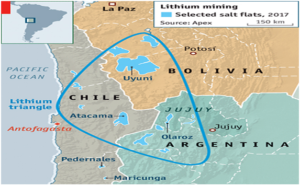
Source: https://pib.gov.in/PressReleasePage.aspx?PRID=2104761Incorrect
Solution (d)
Explanation:
Context: A Memorandum of Understanding (MoU) between Mineral Exploration and Consultancy Limited (MECL), a PSU under the Ministry of Mines, and the Provincial Government of Catamarca, Argentina will pave the way for deeper collaboration in exploration and resource development of critical minerals. Argentina, known for its vast lithium reserves as part of the ‘Lithium Triangle,’ is a crucial partner for India in securing essential minerals required for electric vehicle batteries and renewable energy storage.
The lithium triangle made up of Argentina, Chile, and Bolivia—contains roughly half the world’s known lithium. Hence option d is correct.

Source: https://pib.gov.in/PressReleasePage.aspx?PRID=2104761 -
Question 25 of 35
25. Question
Which of the following statements is true regarding DDoS attacks?
Correct
Solution (c)
Explanation:
Context: In January, the web-based portal Kaveri 2.0, which streamlines property registrations in Karnataka, faced sporadic, crippling server outages. As a result, property registration and document-related citizen services went almost to a standstill in the state. On investigating the outage, the Revenue Department and E-Governance Department concluded that it was not due to “technical glitches” but a “motivated Distributed Denial of Service (DDoS) attack” on Kaveri 2.0 – a portal launched in 2023 to reform land registration.
- In a man-in-the-middle attack, a cybercriminal intercepts communication between two individuals to steal data.
- Malware is malicious software that a cybercriminal/hacker creates to disrupt/ damage computer/s or derive financial benefits.
- In a denial of service (DDoS) attack, computer systems are prevented from fulfilling legitimate requests by overwhelming the networks and servers with excessive traffic. Hence option c is correct.
- In romance scams, cybercriminals use dating sites, chat rooms, and apps to dupe victims into compromising personal data.
Source: https://www.thehindu.com/sci-tech/technology/whats-a-ddos-cyberattack-that-hit-karnatakas-kaveri-20-portal/article69228797.ece
Incorrect
Solution (c)
Explanation:
Context: In January, the web-based portal Kaveri 2.0, which streamlines property registrations in Karnataka, faced sporadic, crippling server outages. As a result, property registration and document-related citizen services went almost to a standstill in the state. On investigating the outage, the Revenue Department and E-Governance Department concluded that it was not due to “technical glitches” but a “motivated Distributed Denial of Service (DDoS) attack” on Kaveri 2.0 – a portal launched in 2023 to reform land registration.
- In a man-in-the-middle attack, a cybercriminal intercepts communication between two individuals to steal data.
- Malware is malicious software that a cybercriminal/hacker creates to disrupt/ damage computer/s or derive financial benefits.
- In a denial of service (DDoS) attack, computer systems are prevented from fulfilling legitimate requests by overwhelming the networks and servers with excessive traffic. Hence option c is correct.
- In romance scams, cybercriminals use dating sites, chat rooms, and apps to dupe victims into compromising personal data.
Source: https://www.thehindu.com/sci-tech/technology/whats-a-ddos-cyberattack-that-hit-karnatakas-kaveri-20-portal/article69228797.ece
-
Question 26 of 35
26. Question
Colour Revolutions refers to peaceful, mass protest uprisings in post-Soviet states, characterized by symbolic colours, aiming to replace pro-Moscow regimes with peaceful and democratic governments.
In this context, consider the following pairs:
Colour Revolution Country - Rose Revolution
Georgia - Orange Revolution
Ukraine - Tulip Revolution
Kyrgyzstan How many above pair/s is/are correctly matched?
Correct
Solution (c)
Explanation:
Context: With the dawn of the 21st century, post-Soviet States experienced a wave of uprisings known as the “colour revolutions”. The movements were associated with specific colours and were largely peaceful protests to replace pro-Moscow governments with pro-West governments in the name of democratic reforms.
Colour Revolutions refers to peaceful, mass-protest uprisings in post-Soviet states, characterized by symbolic colours, aiming to replace pro-Moscow regimes with peaceful and democratic governments.
In this context, consider the following pairs:
Colour Revolution Country - Rose Revolution
Georgia - Orange Revolution
Ukraine - Tulip Revolution
Kyrgyzstan Hence option c is correct.
Incorrect
Solution (c)
Explanation:
Context: With the dawn of the 21st century, post-Soviet States experienced a wave of uprisings known as the “colour revolutions”. The movements were associated with specific colours and were largely peaceful protests to replace pro-Moscow governments with pro-West governments in the name of democratic reforms.
Colour Revolutions refers to peaceful, mass-protest uprisings in post-Soviet states, characterized by symbolic colours, aiming to replace pro-Moscow regimes with peaceful and democratic governments.
In this context, consider the following pairs:
Colour Revolution Country - Rose Revolution
Georgia - Orange Revolution
Ukraine - Tulip Revolution
Kyrgyzstan Hence option c is correct.
-
Question 27 of 35
27. Question
The Experimental Advanced Superconducting Tokamak (EAST) nuclear fusion reactor set a new milestone in nuclear fusion by sustaining plasma at 100 million°C for 1,066 seconds. It is located in which of the following country?
Correct
Solution (b)
Explanation:
Context: In 2023, EAST achieved the world’s first steady-state high-confinement plasma for 403 seconds, a world record it broke on January 20, 2025, by sustaining a plasma for 1,066 seconds.
- The Experimental Advanced Superconducting Tokamak (EAST) nuclear fusion reactor set a new milestone in nuclear fusion by sustaining plasma at 100 million°C for 1,066 seconds. It is located in Hefei, China. Hence option b is correct.
- It advances the pursuit of clean and sustainable fusion energy for future energy security. It aims to replicate the nuclear fusion process that powers the Sun, contributing to the development of sustainable energy.
Source: https://www.thehindu.com/sci-tech/science/china-east-tokamak-keeps-fire-magnetic-fusion-burning/article69226043.ece
Incorrect
Solution (b)
Explanation:
Context: In 2023, EAST achieved the world’s first steady-state high-confinement plasma for 403 seconds, a world record it broke on January 20, 2025, by sustaining a plasma for 1,066 seconds.
- The Experimental Advanced Superconducting Tokamak (EAST) nuclear fusion reactor set a new milestone in nuclear fusion by sustaining plasma at 100 million°C for 1,066 seconds. It is located in Hefei, China. Hence option b is correct.
- It advances the pursuit of clean and sustainable fusion energy for future energy security. It aims to replicate the nuclear fusion process that powers the Sun, contributing to the development of sustainable energy.
Source: https://www.thehindu.com/sci-tech/science/china-east-tokamak-keeps-fire-magnetic-fusion-burning/article69226043.ece
-
Question 28 of 35
28. Question
Lake Chad is a dynamic freshwater body with human presence dating back to the Paleolithic era. In this context, consider the following countries:
- Nigeria
- Cameroon
- Niger
- Chad
The Lake Chad region spans over how many of the following countries?
Correct
Solution (d)
Explanation:
Context: Chad is one of four countries around Lake Chad battling Boko Haram and its allies over the past decade.
Lake Chad is a dynamic freshwater body with human presence dating back to the Paleolithic era. The Lake Chad region spans over Nigeria, Cameroon, Niger, and Chad. Hence option d is correct.
Source: https://www.thehindu.com/news/international/nearly-300-militants-killed-in-boko-haram-offensive-says-chad/article69237162.ece#:~:text=Chad%20is%20one%20of%20four,allies%20over%20the%20past%20decade&text=Chad's%20Army%20said%20that%20it,(February%2020%2C%202025)
Incorrect
Solution (d)
Explanation:
Context: Chad is one of four countries around Lake Chad battling Boko Haram and its allies over the past decade.
Lake Chad is a dynamic freshwater body with human presence dating back to the Paleolithic era. The Lake Chad region spans over Nigeria, Cameroon, Niger, and Chad. Hence option d is correct.
Source: https://www.thehindu.com/news/international/nearly-300-militants-killed-in-boko-haram-offensive-says-chad/article69237162.ece#:~:text=Chad%20is%20one%20of%20four,allies%20over%20the%20past%20decade&text=Chad's%20Army%20said%20that%20it,(February%2020%2C%202025)
-
Question 29 of 35
29. Question
With reference to the Aditya-L1 Mission, consider the following statements:
- It is India’s first space-based solar observatory positioned at the Lagrange Point 1 (L1) of the Sun-Earth system.
- Its objective is to understand coronal heating, coronal mass ejection (CME), and solar wind acceleration.
- Visible Emission Line Coronagraph (VELC) and Solar Low Energy X-ray Spectrometer (SoLEXS) are included as in-situ payloads.
How many of the above statement/s is/are correct?
Correct
Solution (b)
Explanation:
Context: India’s first dedicated space based solar mission, Aditya-L1, has made a ground-breaking observation as one of its scientific payloads has captured the first-ever image of a solar flare ‘kernel’ in the lower solar atmosphere.
- Aditya-L1 Mission is India’s first space-based solar observatory positioned at the Lagrange Point 1 (L1) of the Sun-Earth system. Hence statement 1 is correct.
- Lagrange points are positions in space where the gravitational forces of two large orbiting bodies, like the Earth and Sun, produce regions of equilibrium where a smaller object can orbit while using minimal fuel. There are 5 Lagrange points, labelled L1 to L5. L1, L2, and L3 lie along the line connecting the two large masses.
- Lagrangian Point 1 or L1 is one of the gravitationally stable points in space where the gravitational forces of two large bodies, like the Sun and Earth, balance out. Located about 1.5 million km from Earth towards the Sun, L1 provides an uninterrupted view of the Sun without any eclipses or occultations.
- Its objective is to understand coronal heating, coronal mass ejection (CME), solar flares, solar wind distribution and temperature anisotropy, near-earth space weather, and solar wind acceleration. Hence statement 2 is correct.
- Visible Emission Line Coronagraph (VELC), Solar Ultra-violet Imaging Telescope (SUIT), High Energy L1 Orbiting X-ray Spectrometer (HEL1OS), and Solar Low Energy X-ray Spectrometer (SoLEXS) are included as remote sensing payloads. Hence statement 3 is incorrect.
- Aditya Solar Wind Particle Experiment (ASPEX), Advanced Tri-axial High-Resolution Digital Magnetometers (MAG), and Plasma Analyser Package for Aditya (PAPA) are included as in-situ payloads.
Source: https://www.thehindu.com/sci-tech/science/aditya-l1-payload-captures-the-first-ever-image-of-a-solar-flare-kernel/article69274469.ece
Incorrect
Solution (b)
Explanation:
Context: India’s first dedicated space based solar mission, Aditya-L1, has made a ground-breaking observation as one of its scientific payloads has captured the first-ever image of a solar flare ‘kernel’ in the lower solar atmosphere.
- Aditya-L1 Mission is India’s first space-based solar observatory positioned at the Lagrange Point 1 (L1) of the Sun-Earth system. Hence statement 1 is correct.
- Lagrange points are positions in space where the gravitational forces of two large orbiting bodies, like the Earth and Sun, produce regions of equilibrium where a smaller object can orbit while using minimal fuel. There are 5 Lagrange points, labelled L1 to L5. L1, L2, and L3 lie along the line connecting the two large masses.
- Lagrangian Point 1 or L1 is one of the gravitationally stable points in space where the gravitational forces of two large bodies, like the Sun and Earth, balance out. Located about 1.5 million km from Earth towards the Sun, L1 provides an uninterrupted view of the Sun without any eclipses or occultations.
- Its objective is to understand coronal heating, coronal mass ejection (CME), solar flares, solar wind distribution and temperature anisotropy, near-earth space weather, and solar wind acceleration. Hence statement 2 is correct.
- Visible Emission Line Coronagraph (VELC), Solar Ultra-violet Imaging Telescope (SUIT), High Energy L1 Orbiting X-ray Spectrometer (HEL1OS), and Solar Low Energy X-ray Spectrometer (SoLEXS) are included as remote sensing payloads. Hence statement 3 is incorrect.
- Aditya Solar Wind Particle Experiment (ASPEX), Advanced Tri-axial High-Resolution Digital Magnetometers (MAG), and Plasma Analyser Package for Aditya (PAPA) are included as in-situ payloads.
Source: https://www.thehindu.com/sci-tech/science/aditya-l1-payload-captures-the-first-ever-image-of-a-solar-flare-kernel/article69274469.ece
-
Question 30 of 35
30. Question
Q.50) If the President of India exercises his power as provided under Article 356 of the Constitution in respect of a particular State, then
Correct
Solution (b)
Explanation:
Context: Four days after N Biren Singh resigned as Chief Minister, the Centre announced that President’s rule had been imposed in Manipur and the state assembly placed under suspended animation.
- President Rule (Article 356) is imposed in a state if the state government cannot be carried on in accordance with the provisions of the constitution.
- Proclamation of President’s Rule must be approved by both the Houses of Parliament within two months from the date of its issue. The approval takes place through a simple majority.
- Initially, the President’s rule is valid for six months and it can be extended for a maximum period of three years with the approval of the Parliament, every six months.
- It is also known as a ‘State Emergency’ or ‘Constitutional Emergency’.
- In case of failure of constitutional machinery, the state legislature is suspended and the executive authority of the state is assumed by the president in whole or in part.
- President by proclamation can declare that the powers of the Legislature of the State shall be exercisable by or under the authority of Parliament. Hence option b is correct.
Source: https://indianexpress.com/article/india/manipur-president-rule-imposed-9830795/
Incorrect
Solution (b)
Explanation:
Context: Four days after N Biren Singh resigned as Chief Minister, the Centre announced that President’s rule had been imposed in Manipur and the state assembly placed under suspended animation.
- President Rule (Article 356) is imposed in a state if the state government cannot be carried on in accordance with the provisions of the constitution.
- Proclamation of President’s Rule must be approved by both the Houses of Parliament within two months from the date of its issue. The approval takes place through a simple majority.
- Initially, the President’s rule is valid for six months and it can be extended for a maximum period of three years with the approval of the Parliament, every six months.
- It is also known as a ‘State Emergency’ or ‘Constitutional Emergency’.
- In case of failure of constitutional machinery, the state legislature is suspended and the executive authority of the state is assumed by the president in whole or in part.
- President by proclamation can declare that the powers of the Legislature of the State shall be exercisable by or under the authority of Parliament. Hence option b is correct.
Source: https://indianexpress.com/article/india/manipur-president-rule-imposed-9830795/
-
Question 31 of 35
31. Question
Passage
Different factors affect the pace of spatial transformations in different ways. In India, people live in the largest cities than in small towns when compared to China. Nearly 6 per cent of the urban population lives in the largest cities in India, which is double compared to China. Most modern cities in India are undergoing haphazard growth, and because of this, the effects of living in huge cities have not been fully anticipated. The social, economic, and psychological consequences of industrialisation and urbanisation have not been fully considered and the steps which should have been taken to bring about an adjustment between man and his new environment have not been forthcoming in ample measure. This is particularly true in the case of underdeveloped regions.
Q.31) Which of the following is/are the most rational and logical inference/s that can be drawn from the passage?
- India is more urbanized than China.
- There is a lack of systematic policy approach to India’s urbanization.
Select the correct answer from the code given below:
Correct
Solution (b)
Explanation
Inference 1 is incorrect: That the given inference is correct cannot be concluded from the passage. For example, the passage says, “In India, people live in the largest cities than in small towns when compared to China. Nearly 6 per cent of the urban population lives in the largest cities in India, which is double compared to China.” The author compares the sub-sections of urban population in India and China. From the given information, we cannot gauge anything about the relative degree of urbanisation. Therefore, this answer option is beyond the scope of the passage.
Inference 2 is correct: The given inference is correct as it can be inferred from the following lines – “Most modern cities in India are undergoing haphazard growth, and because of this, the effects of living in huge cities have not been fully anticipated. The social, economic, and psychological consequences of industrialisation and urbanisation have not been fully considered …” These lines clearly imply that it is the lack of systematic policy approach which is resulting in haphazard urbanization. Therefore, this answer option is correct.
Incorrect
Solution (b)
Explanation
Inference 1 is incorrect: That the given inference is correct cannot be concluded from the passage. For example, the passage says, “In India, people live in the largest cities than in small towns when compared to China. Nearly 6 per cent of the urban population lives in the largest cities in India, which is double compared to China.” The author compares the sub-sections of urban population in India and China. From the given information, we cannot gauge anything about the relative degree of urbanisation. Therefore, this answer option is beyond the scope of the passage.
Inference 2 is correct: The given inference is correct as it can be inferred from the following lines – “Most modern cities in India are undergoing haphazard growth, and because of this, the effects of living in huge cities have not been fully anticipated. The social, economic, and psychological consequences of industrialisation and urbanisation have not been fully considered …” These lines clearly imply that it is the lack of systematic policy approach which is resulting in haphazard urbanization. Therefore, this answer option is correct.
-
Question 32 of 35
32. Question
Which of the following statements best reflects the crux of the passage?
Correct
Solution (c)
Explanation
Option (a) is incorrect: The central theme of the passage is about the poor urbanization model/policy. The context of the role of urbanization in rapid economic growth is not covered in the passage. Therefore, it does not reflect the best crux of the passage.
Option (b) is incorrect: The passage mostly covers the pattern and consequences of urbanisation. The context of villages has not been discussed in the passage.
Option (c) is correct: The passage covers the lack of structured policy in Indian urbanization. The following lines “Most modern cities in India are undergoing haphazard growth, and because of this, the effects of living in huge cities have not been fully anticipated” show that there is a lack of coherent policy approach. This shows that the current trend of urbanization is not sustainable and needs to be changed. So, this is the best crux of the passage.
Option (d) is incorrect: To state that industrialization and urbanization go together is not covered in the passage. Also, it is not the central theme which is about the lack of a systematic approach to urbanization.
Incorrect
Solution (c)
Explanation
Option (a) is incorrect: The central theme of the passage is about the poor urbanization model/policy. The context of the role of urbanization in rapid economic growth is not covered in the passage. Therefore, it does not reflect the best crux of the passage.
Option (b) is incorrect: The passage mostly covers the pattern and consequences of urbanisation. The context of villages has not been discussed in the passage.
Option (c) is correct: The passage covers the lack of structured policy in Indian urbanization. The following lines “Most modern cities in India are undergoing haphazard growth, and because of this, the effects of living in huge cities have not been fully anticipated” show that there is a lack of coherent policy approach. This shows that the current trend of urbanization is not sustainable and needs to be changed. So, this is the best crux of the passage.
Option (d) is incorrect: To state that industrialization and urbanization go together is not covered in the passage. Also, it is not the central theme which is about the lack of a systematic approach to urbanization.
-
Question 33 of 35
33. Question
Consider the following statements:
- Some capitals are continents.
- All continents are countries.
- Some countries are islands.
Conclusions:
- Some islands are continents.
- Some countries are continents.
- Some countries are capitals.
- Some islands are capitals
Based on the given statements, which of the conclusion(s) is/are true?
Correct
Solution (b)
Explanation
We can make the following Venn diagram based on the given statements:
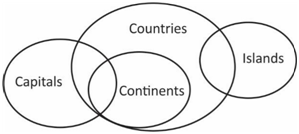
From the diagram we can infer that some Countries are Continents and some Countries are Capitals. Hence, option (b) is the correct answer.
Incorrect
Solution (b)
Explanation
We can make the following Venn diagram based on the given statements:

From the diagram we can infer that some Countries are Continents and some Countries are Capitals. Hence, option (b) is the correct answer.
-
Question 34 of 35
34. Question
Three statements are given below followed by four conclusions numbered I, II, III and IV. You have to take the three given statements to be true even if they seem to be at variance with commonly known facts. Read the given conclusions and then decide which of the given conclusions logically follow(s) from the given statements disregarding commonly known facts.
Statements:
- Some cakes are milk.
- Some milks are curd.
- No curd is yogurt.
Conclusions:
- No cake is a yogurt.
- No milk is a yogurt.
- Some milk are yogurt.
- Some cakes are curd.
Which of the above conclusions is/are correct?
Correct
Solution (d)
Explanation
On the basis of the given statements, the following Venn diagram can be drawn:
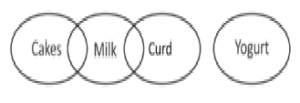
Conclusions II and III form a complementary pair. Hence, either II or III follows. Hence, option (d) is the right answer.
Incorrect
Solution (d)
Explanation
On the basis of the given statements, the following Venn diagram can be drawn:

Conclusions II and III form a complementary pair. Hence, either II or III follows. Hence, option (d) is the right answer.
-
Question 35 of 35
35. Question
Two statements are given below followed by a question.
Statement 1:
The number when multiplied by 4, produces an even number.
Statement 2:
Sum of its digits is even.
Question: Is the two-digit number odd?
Correct
Solution (d)
Explanation
Two-digit odd number means unit digit would be 1, 3, 5, 7 or 9.
Statement 1:
When a number is multiplied by 4, it will always produce an even number. So, S1 alone is not sufficient to answer the question.
Statement 2:
Sum of its digits can be even if both digits are odd, e.g. 51, 31, 11, 57 Or Sum of its digits can be even if both digits are even, e.g. 26, 48, 82, 68 So, S2 alone is also not sufficient to answer the question.
Even both S1 & S2 together are not sufficient to answer the question. Hence, option (d) is the correct answer.
Incorrect
Solution (d)
Explanation
Two-digit odd number means unit digit would be 1, 3, 5, 7 or 9.
Statement 1:
When a number is multiplied by 4, it will always produce an even number. So, S1 alone is not sufficient to answer the question.
Statement 2:
Sum of its digits can be even if both digits are odd, e.g. 51, 31, 11, 57 Or Sum of its digits can be even if both digits are even, e.g. 26, 48, 82, 68 So, S2 alone is also not sufficient to answer the question.
Even both S1 & S2 together are not sufficient to answer the question. Hence, option (d) is the correct answer.
All the Best
IASbaba

